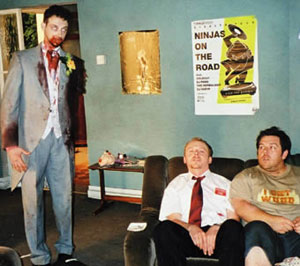A technique used a lot in Lord of the Rings and Pirates of the Caribbean is to dress the actor who is playing the part of a CGI humanoid in a special suit that enabled their co-stars to react to a real person while still having the CGI added in post-production. This takes away the need for said actor to go through hours of prosthetic make up which can sometimes be heavy and uncomfortable for them to wear for a full day of shooting. It can also sometimes be impossible to create the effects desired with prosthetic make up.
Here are some examples of using this technique:
1. Gollum
Andy Serkis spent the whole shoot wearing a special suit that was covered in dots that a special camera would use to track his movements in order to animate the CGI Gollum in post-prod.
The uniformly placed dots on his face were also for this motion capture technique and they were very important in capturing any facial expressions Serkis was portraying as he was acting the part.
2. Davy Jones
The same technique was used in Pirates of the Caribbean: Dead Man’s Chest and PotC: At World’s End with Bill Nighy playing Davy Jones.
Here’s a short video of how an actor in pyjamas becomes a villain:
When asked about how the motion capture suit affected his performance, Nighy said this:
“Its not even how does it effect my performance its how does it effect my sense of myself as a man. Its like terrible, it’s awful. The bad bit was the first week. The first week you walk on to a huge, American film set, everybody else looks fabulous. There’s Johnny Depp, I mean, please, give me a break. There’s Orlando Bloom, Geoffrey Rush, everyone looks fabulously piratey and then there’s me. Dressed in a grey pajama suit with white bubbles all over and a silly hat. You look really lame, you know? It was one of the hardest weeks of my professional life, but they ran out of jokes on a Thursday so…” [citation]
3. Avatar
The same technique was used to get the performance for the Na’vi characters, especially Jake Sully and Neytiri as seen here:
As you can see, they are essentially dressed as the characters, rather than wearing the motion capture suits. Perhaps a full suit wasn’t necessary for these characters because they’re so close to being human, the only main differences being in the face and body colour (and comparative height to normal humans). Of course, James Cameron is well known for experimenting with the very latest in visual effects, so we may not need the funny looking pyjamas at all ten years down the line.
Personally, I think the best way of creating a character is to go as far as possible with prosthetics before having to move into CGI. Some of my favourite film characters are made with a mixture of prosthetics and CGI.
The film Pan’s Labyrinth is an excellent example of this. Here is a clip of an interview with Doug Jones, who plays Pan and Pale Man in the film explaining his processes of becoming both these characters:
Here is another video of the writer and director, Guillermo Del Toro, and visual effects producers going more in-depth about the make up and special effects used in Pan’s Labyrinth:
One example of a CGI effect that couldn’t possibly be done with prosthetics (without consideration harm to the actor) was the removal of Lord Voldemort‘s nose in the Harry Potter series. The rest of his face and head was covered with prosthetic make up and his nose was digitally removed by way of tracking dots carefully positioned around the nasal area. This video briefly demonstrates how this is achieved:
Using a combination of CGI and Prosthetics has been largely in use in the horror film genre to achieve an effect of eg. a torn off limb or various missing body parts that obviously couldn’t be done in real life. And so, again, prosthetic make up is used as much as possible then a green or blue cover is added in order for the missing part to be digitally removed later.
An excellent example of this kind of combination is in the TV series Walking Dead, and there is one particular character known as Bicycle Girl for whom these effects are most advantageous. Here is an explanation of how they created the look and a time lapse of how her costume comes together:
A different route to go down is to use actual amputees and using the fact that they are missing limbs to cut the cost of CGI and special effects. This was the method used in the film Shaun of the Dead. The main character actors speak about this during their commentary, and Pegg notes that many of the amputees are made up to look like they did when they originally lost their missing limbs but they were still more than happen to partake.

The gentleman playing the zombie is an amputee who had to wear a prosthetic arm when seen in the corner shop earlier in the film.
In conclusion, I believe there is a suitable time and place for using CGI instead of prosthetics. I think while the most advanced computer graphics aren’t too widely available, film makers who are looking for a realistic effect should follow down the path of prosthetics as much as possible. If it can’t be done with prosthetics then by all means use CGI but it needs to look believable.
Editor’s note: The majority of the information I got for this post was learnt from behind the scenes documentary extras on DVDs of the mentioned films/TV shows. As such I cannot source the references with links.

